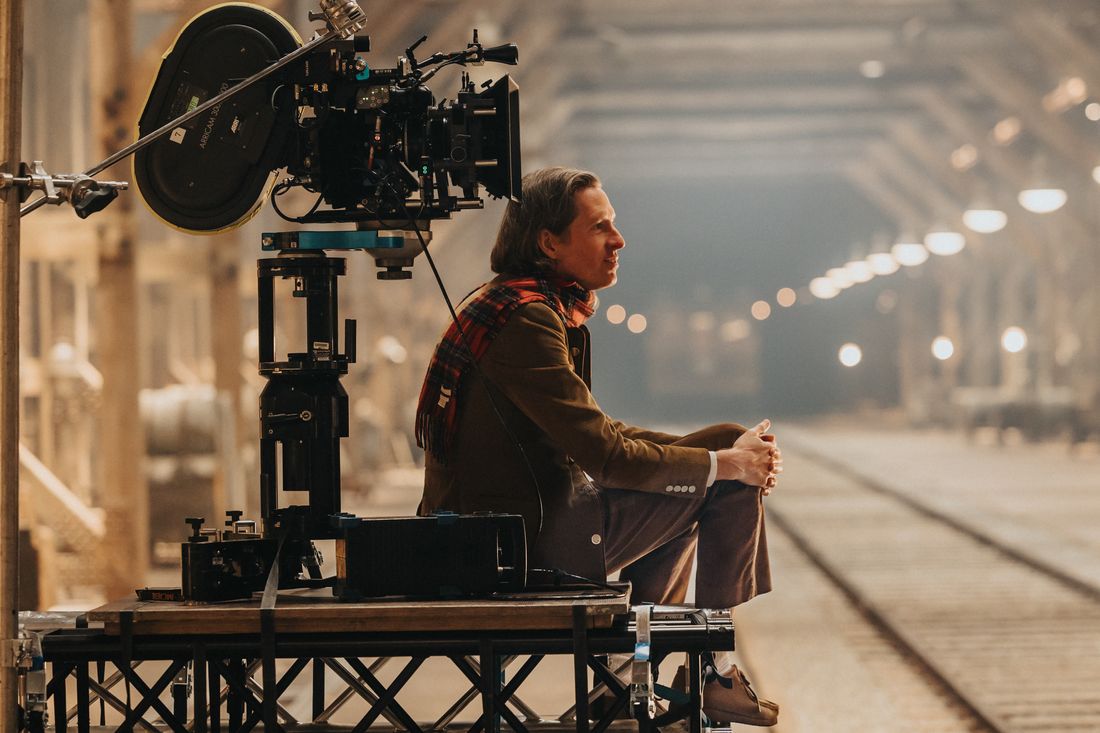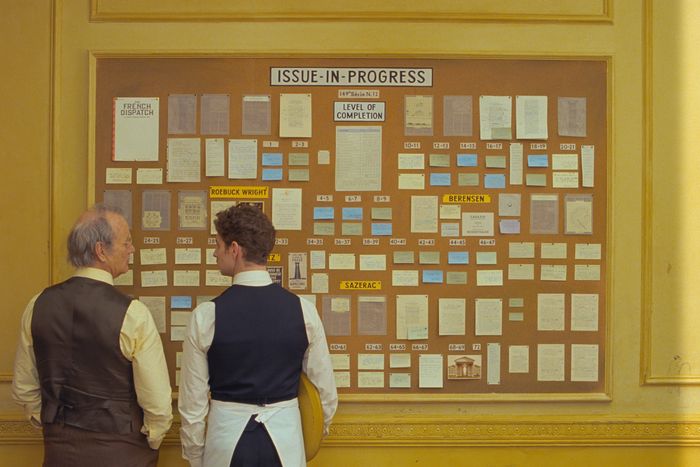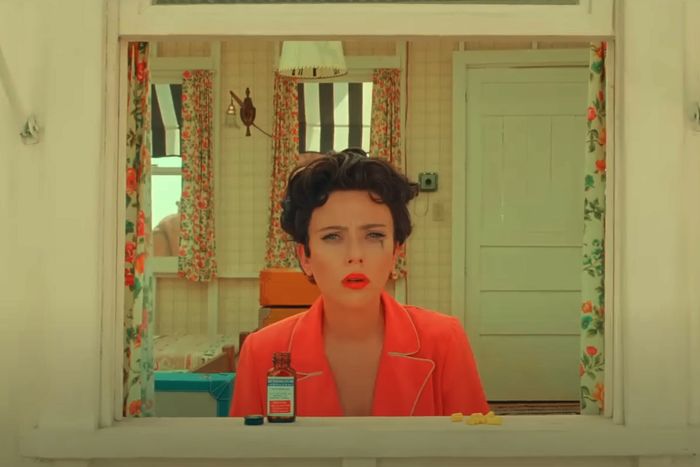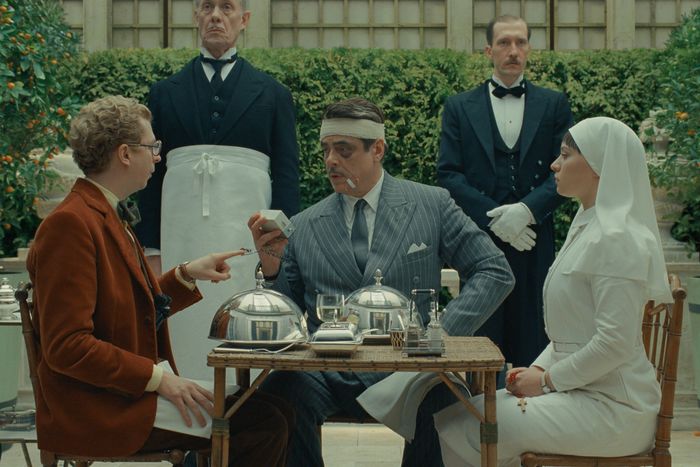

Photo: Roger Do Minh/TPS Productions/Focus Features
“The boy was murdered, I think, by the people who were meant to love him.”
Wes Anderson is talking about a surreal moment that occurs early in his latest film, The Phoenician Scheme, in which the protagonist, the ruthless international tycoon Zsa-Zsa Korda (Benicio del Toro), experiences a vision of the afterlife. Zsa-Zsa has just had a close call with death, and now he finds himself attending a heavenly black-and-white funeral for a young boy whose body lies in a coffin. Is that someone Zsa-Zsa knows? Is it himself? Is this a dream? Zsa-Zsa sees his long-dead grandmother sitting next to him. “Why are we here?” he asks her. She doesn’t recognize him. Then, the boy in the coffin wakes up — and so does Zsa-Zsa.
The Phoenician Scheme (which is about to premiere at this year’s Cannes Film Festival) might be a comedy — perhaps Anderson’s funniest in years — but it’s also the sort of comedy he has specialized in for the past decade or so: Its fanciful narrative is laced with existential dread, gathering evil, and a restless fascination with mortality. Zsa-Zsa’s visions of the afterlife don’t stop with the funeral. Over the course of the picture, he regularly finds himself at the center of some sort of heavenly tribunal. Inspired by the work of Surrealist filmmaker Luis Buñuel, with a bit of Michael Powell dreaminess thrown in, these black-and-white hallucinations have no denominational consistency: Each is different, with the actors (including Bill Murray and F. Murray Abraham) in clearly fake makeup and prosthetics. “These scenes are something in Zsa-Zsa’s brain — some neurological experience that he’s having,” Anderson says. “Somewhere along the line, we realize this guy is being confronted with his own death so aggressively and overtly that it’s actually starting to change his view of the world, which is not something he’s ever been open to. And what he’s learning in those moments I guess he’s learning from himself.”
As played by del Toro, whose statuesque glower and massive eyes seem to switch easily from sociopathic determination to utter bafflement, Zsa-Zsa is a transfixing figure, and it’s not surprising to learn that the main impetus for The Phoenician Scheme was the director’s desire to put this particular actor at the center of a movie. They were premiering The French Dispatch at Cannes in 2021 when Anderson told del Toro that he was thinking of casting him as a European tycoon, of the sort one might find in an Italian film from the 1960s. The character was then crossbred with a variety of other inspirations, chief among them Anderson’s late father-in-law, Fuad Malouf (to whom the picture is dedicated), a Lebanese engineer who had a vast array of ongoing international projects. “When he started to get dementia some years ago, he chose to show my wife how his world operates,” Anderson says. “He went into the back of this closet and came out with all these shoe boxes, and he laid them out. And he said, ‘This is the project in Saudi, with these brothers. This is the project in Gibraltar, with these other people,’ and so on. It was like a Dickensian thing, like Bleak House or something.” What the director describes resembles a moment in The Phoenician Scheme in which Zsa-Zsa, having just survived an assassination attempt, pulls out a bunch of boxes and explains to his novitiate daughter, Liesl (Mia Threapleton), his various business dealings, in the hopes that she will one day inherit and manage it all.
Malouf could be intimidating, but Anderson says they got along very well. The more sinister and complicated aspects of Zsa-Zsa’s character — his greed, his chicanery, his vindictiveness, his paranoia, his disregard of his family, his cavalier attitude toward paying people and the suffering of others — came from a variety of other 20th-century business figures, including the notorious shipping magnate Aristotle Onassis; the film producer Carlo Ponti; the Hungarian banker Árpád Plesch; and the Armenian fixer Calouste Gulbenkian, the infamous middleman known as “Mr. Five Percent,” who helped Western companies exploit the oil-producing regions of the Middle East.
Michael Cera, Benicio del Toro, and Mia Threapleton in The Phoenician Scheme.
Photo: TPS Productions/Focus Features
In The Phoenician Scheme, the widely despised but often deadpan-hilarious Zsa-Zsa finds himself financially encircled by his foes when the price of a key bolt is jacked up to astronomic levels, which prompts him to fly from country to country renegotiating deals with his business partners, finagling them into covering the higher costs of his various construction projects. Basically, it’s a story about trade wars and economic blackmail, and at the center of it is a cruel absentee father and cynical megalomaniac who loves to cut terrible deals. (It might also be the first Wes Anderson film where the audience has to do some math.) And if it feels like both the movie and its protagonist echo certain troubling aspects of contemporary reality — in their own hermetically sealed, Wes Anderson kind of way — it wouldn’t be the first time. “What ends up happening often is that when you make a movie, if you’re drawing on something historical, then two weeks into shooting, something happens that makes you say, ‘Well, it’s actually happening now, too,’” he says. We happen to be FaceTiming on the day that Donald Trump announced he was going to put a 100 percent tariff on films produced abroad. “I’m not even going to try to think about what that could possibly mean,” Anderson says with a bitter laugh. “A 100 percent tariff on movies. So what does that mean? You’ll take all the money?”
Even so, Anderson doesn’t see his protagonist, for all his Trumpian qualities, as an avatar for the current president. “I don’t think Donald Trump specifically possesses anything like a moral compass, whereas Zsa-Zsa, I think, does,” he says. “Zsa-Zsa has a moral compass, but he doesn’t care. That fact also permits him to maybe find a better potential in himself over the course of the story.”
While Anderson has a reputation for making manicured and lighthearted trifles (we’re not calling them twee anymore, thank God), you’d have to be blind to miss the darkness that has crept into his chocolate-box creations. Grand Budapest Hotel (2014) goes from being a romp about a resourceful playboy concierge in a made-up central European country to a drama about a fascist takeover, with closing borders, random arrests, and the decay of civility. And the animated allegory Isle of Dogs (2018) is set in and around an imaginary Japanese city where a corrupt mayor-cum-dictator has banned all dogs to an abandoned island. Say all you want about how Wes Anderson lives in his own universe, but he started making movies about the rise of authoritarianism well before a lot of other ostensibly more political artists did. In fact, even as his style has seemed to become even more ornate, the subjects he has been tackling feel more and more as if they’ve been ripped from the headlines.
None of that came from some desire for contemporary topicality, however. It was more a sign of his expanding point of view. “Where I grew up, until I was 20 years old, it was a very small world,” Anderson, who was born and raised in Houston, says. “At a certain point, I did choose to try to have a broader perspective than the one I grew up with.” Moving to Paris in the mid-2000s led to a major shift, he says. As did, surely, starting a family. One of the pleasures of watching Anderson’s films over the years is that he and his work have grown up before our eyes, moving from the precocious coming-of-age stories of his early career — where even the older characters’ stirrings of mortality felt like the vague ruminations of a thoughtful and earnest young man projecting himself into the future — to the more pensive later efforts, which are steeped in regret and a paradoxical embrace of the enigmatic nature of life. “By the time we were doing Asteroid City, certainly those questions were at the center of the whole movie,” he says now, referring to his 2023 picture that tackles (among other things) the bewildering nature of both the cosmos and the human heart. “Mystery is the motivation for that film in the first place, I think — mystery around death and around making some concept of poetry or art.”
Asteroid City built on the dense and perplexing anthology of The French Dispatch, which presented a series of stories about journalists. In each of these episodes, characters long to break free of their realities without ever quite knowing how: an imprisoned mentally ill artist in love; French students rebelling against a system that predetermines their fate; and a gay African American writer (modeled partly after James Baldwin) living in self-exile in France who pours all his emotions into impeccably crafted articles about food. That film’s repeated mantra — “Try to make it sound like you wrote it that way on purpose,” offered up by a domineering magazine editor to all his writers young and old — could easily be Anderson’s own. In his work, a veil of purposefulness hides the despair. Artifice masks the presence of the unknown.
Oddly enough, as Anderson has become wiser and more reflective, his pictures have become downright meme-worthy in their fastidiousness and precision. The director’s camera moves are exacting, and his compositions carefully arranged, like a cross between a mid-century Belgian comic book and a prizewinning American high-school science-fair project. Some have wondered if he’ll ever relent and go back to working in a more naturalistic vein. Instead, he’s doubled down. “That’s not always my choice,” he says, laughing again. “Somehow, whatever I do, it ends up seeming like I did it. When it’s processed through me, it kind of comes out this way. If you were sitting there next to me, and you said, ‘I can tell you some ways to make this seem like you didn’t do it. Move the camera over here,’ I would probably say, ‘I know … but I think I like it more here.’”


From left: The French Dispatch. Photo: Searchlight Pictures/Everett CollectionAsteroid City. Photo: Focus Features/Everett Collection
From top: The French Dispatch. Photo: Searchlight Pictures/Everett CollectionAsteroid City. Photo: Focus Features/Everett Collection
But now, to go along with the images, his work has become structurally ornate as well. Asteroid City is, at various points, a movie, a 1950s TV drama, a play, and a radio play, even as a voice-over reminds us that not only did none of these things ever happen, the creation we’re watching is itself a phantom. (“Asteroid City does not exist,” a narrator tells us. “It is an imaginary drama created expressly for the purposes of this broadcast. The characters are fictional, the text hypothetical, the events an apocryphal fabrication.”) The French Dispatch, meanwhile, is presented as a series of articles in the final issue of a (fictional) magazine, with each story descending into its own network of flashbacks and memories and projections and tales-within-tales, switching between color and black-and-white and hopping aspect ratios with gleeful abandon. These complications reach almost pathological levels, so that by the end of these films, we feel, along with the characters, a moving sense of lostness. “It’s partly what I like in cinema,” Anderson says. “When something gets more abstract, it moves me. It’s an area I’m more drawn to than when I was younger.”
That disorientation is key to the films’ effect. As I put it in my Asteroid City review: “Anderson’s obsessively constructed dioramas explore the very human need to organize, quantify, and control our lives in the face of the unexpected and the uncertain.” Much like their creator, his characters fret over details and seek to predict and manage their world. But the precision achieves the opposite on both levels: The mad swirl of the stories-within-stories results in overwhelming ambiguity, and with each new effort, the characters seem to be less and less in control. When I start to run this idea by Anderson, he interrupts me with a smile: “Maybe that’s why they’re so controlled,” he says.
Believe it or not, once upon a time, Wes Anderson thought of himself as someone from the John Cassavetes school of filmmaking — or, at least, he tried to. He valued spontaneity and the idea of improvisation. On his first feature, Bottle Rocket, he sometimes tried to get his actors to respond to things they didn’t know were coming. “I knew about how William Friedkin could really throw a wrench into things on the set, and something spontaneous would happen,” he says. So, for one scene, he had an actress throw a banana daiquiri in Owen Wilson’s face without telling him. “When it happened, Owen just stopped and said, ‘Why did you do that?’ And she said, ‘Wes told me to,’” Anderson recalls. “This spontaneous moment that I was hoping to capture was immediately rendered completely impossible. And Owen was so upset! He felt so betrayed.” Maybe the idea was right, but it seemed to be the wrong approach for Anderson. “I had to go follow Owen a quarter of a mile off into the distance while he pulled himself together and I tried to explain. Then the wardrobe people came over to me and said, ‘There’s no double for Owen’s shirt.’”
So, the Cassavetes/Friedkin approach went out the window, but the idea of finding spontaneity in these increasingly manicured works didn’t. “When we made The Darjeeling Limited, we had a system for how we would shoot the movie: We would plan out what we could and get everything in order, and then whatever happened, we were going to use it in the movie,” Anderson says, explaining how he tried an open-ended approach for his 2007 production, shot in India. “There were times when things really took sharp turns from what we anticipated and planned, and we adapted to them and just tried to go with them.” Did it work? Darjeeling Limited got Anderson some of his more dismissive reviews at the time — but like a couple of his other films, its reputation has only grown in subsequent years.
Anderson credits the process of making his first animated feature, The Fantastic Mr. Fox (2009), with giving him the ability to exert greater control over his shots. Since then, he’s extensively used animatics to prepare his scenes. (He describes it as “a storyboard cartoon version of the scenes,” and then adds, “We just call it the cartoon.”) At first, these were meant primarily for his production designer, Adam Stockhausen, and his cinematographer. (Robert Yeoman shot all of Anderson’s live-action features up until The Phoenician Scheme, which was shot by Bruno Delbonnel.) Over the years, some actors asked to see them as well. “It started with Willem Dafoe,” Anderson says. “He started telling the other actors, ‘Watch this thing! This is what he actually wants you to do.’” Some, on the other hand, didn’t want anything to do with it: “The cartoon is the last thing Ralph Fiennes wants to see.”
So what role does uncertainty now play for him? In a situation where everything is so disciplined, and where his style has become so meticulous, does Anderson still want the variability of life to sneak in? Again, he focuses on his actors. “When you’re working with somebody like Benicio, or somebody like Timothée Chalamet, or Benedict Cumberbatch,” he says, “those are all actors who dare you to capture whatever happens this time. They’re going to go this way, and then they’re going to go that way, and you get to say, ‘Okay, let’s see what’s going to happen here.’ Benicio has a monumental aspect to him. And sometimes you’re wondering which side of the monument you’re going to wind up on.”
Which brings us back to that dead boy and Zsa-Zsa’s visions and his heavenly tribunals, which add an ongoing element of dream logic and psychological entropy to The Phoenician Scheme’s labyrinthine, onscreen-math-filled tale. We can try to interpret and categorize these little moments, but they’re so fleeting and elusive. They’re clearly filled with symbols and ideas, but they don’t entirely fall into place — because, ultimately, they’re just brief flashes from an unraveling mind. “I think Zsa-Zsa is a control freak who’s lost all his power,” Anderson says. “Some neurons are sparking in new directions, and the biggest effect is happening when his eyes are closed.” In other words, he has become a quintessential Wes Anderson character: A person whose desire to put everything in boxes has resulted in existential chaos and endless soul-searching.






